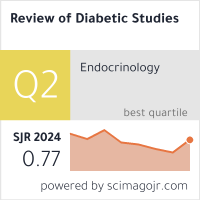Association Of VEGF And Microrna-221Expression With MTHFR Gene Polymorphism; AMolecular Insight Into Angiogenic And GeneticRegulatory Pathways
DOI:
https://doi.org/10.1900/0s4ztt28Keywords:
Diabetic retinopathy, MTHFR gene, folate metabolism, gene expression, metabolic pathways, RT-PCR.Abstract
Diabetic retinopathy (DR), a prominent microvascular consequence of type 2 diabetes, is influenced by a wide range of variables, both hereditary and physiological. One hundred fifty samples of blood were collected from human subjects for the purpose of this study. Participants were divided into three equal groups: diabetics with retinopathy (DR), diabetics without retinopathy (DM), and healthy adults without diabetes (control). A study was conducted on the genetics of two MTHFR single-nucleotide polymorphisms (rs1801133 and rs1801131), along with the expression analysis of the VEFG, and miR-221 genes. The AA genotype at rs1801133 is associated with a heightened risk of diabetic retinopathy (p = 0.011), while the TT genotype at rs1801131 correlates with increased homocysteine levels. This was identified through the analysis of genetic polymorphisms in the MTHFR gene. The DR group exhibited a noteworthy elevation in MTHFR gene expression, which was correlated with a significant increase in VEGF expression. This indicated the activation of augmented angiogenic pathways linked to retinal damage. It is possible that the DR group is responsible for the highest levels of gene expression of microRNA-221 (miR-221), which suggests that it plays a role in inflammatory responses and cell-mediated immunity in the context of DR. The study found physiologic and genetic causes of diabetic retinopathy. Gene expression analysis, genetic polymorphisms, and conventional biomarkers enhance early diagnostic and prognostic tools. These findings emphasize to the need for multi-level research and personalized medicine in diabetic complications to better comprehend pathogenic mechanisms and develop effective treatments. The study's findings shed light on one of diabetes' most serious retinal damage complications and aid in treatment.
Downloads
Published
Issue
Section
License
Copyright (c) 2025 Mohammed Adil Jebur, Wiaam Ahmed Al-Amili, Zeena Adnan Abd

This work is licensed under a Creative Commons Attribution-ShareAlike 4.0 International License.


